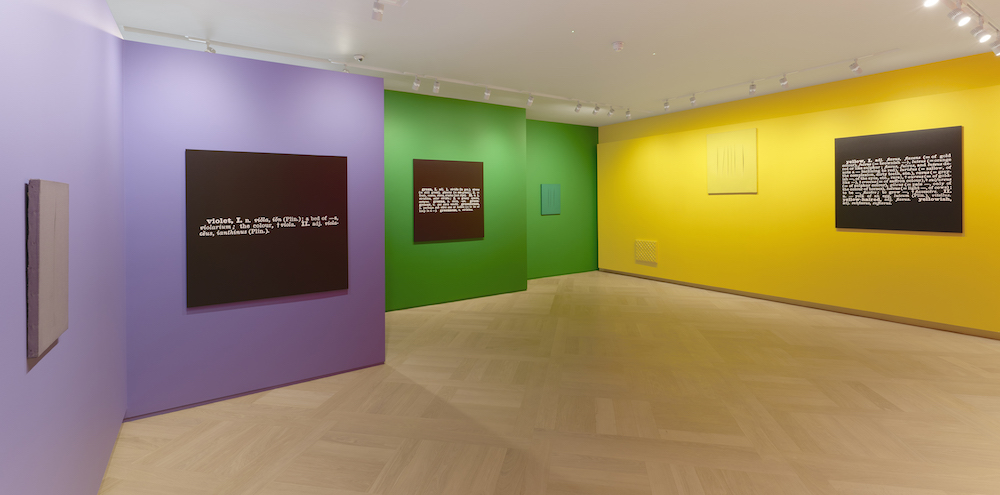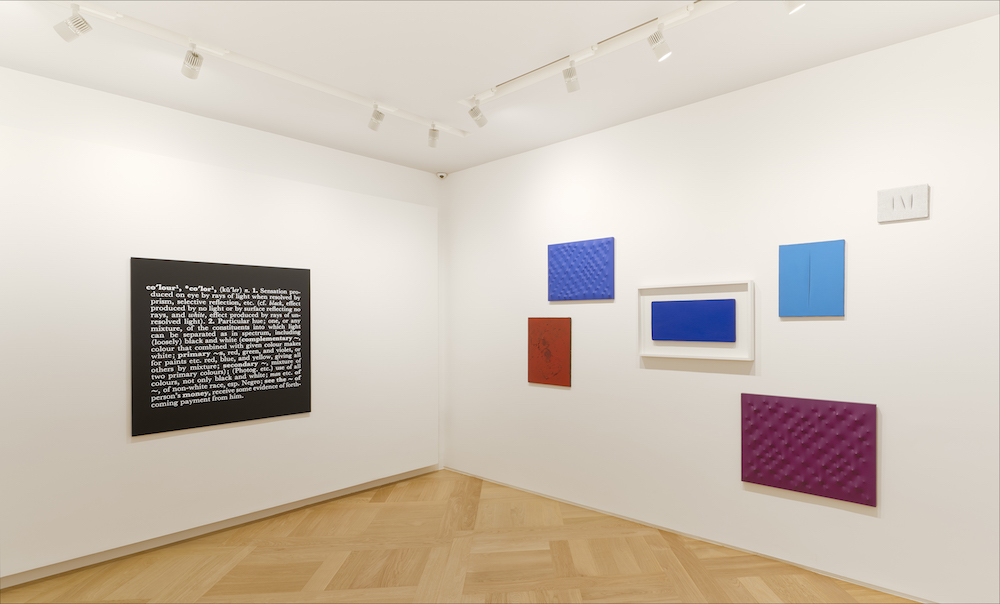
Aside Kosuth, whose work features prominently in the exhibition at Mazzoleni London, Enrico Castellani, Lucio Fontana, Yves Klein and Piero Manzoni are also present. For the American artist, this follows an ongoing exploration of his work and texts alongside others—often with key elements juxtaposed.
“It’s an installation work in the series I’ve called Curated Installations now for several decades,” Kosuth tells me, “in which I put into linguistic play a variety of elements. Often the works of other artists are featured in a multiple, juxtapositioning with texts or even my own works. So in this installation, I filled the walls of the gallery with paintings by artists that Mazzoleni normally works with and put them in play with a series of my definition works from the 1960s on colour. The response to the exhibition has been incredibly positive.”
Colour is explored from many angles, and there is an inclusion of monochrome works from Kosuth’s four fellow artists alongside his late-sixties series Art as Idea as Idea
for a site-specific installation. Colour is present at points through its absence, allowing the viewer to consider far beyond the realm of aesthetics (as all of these artists do so powerfully, independently of one another also). Colour is bent and shadowed by form—as in the simply punctuated works of Castellani—and powerfully sliced, placing solid and vivid colour next to the black void—as in the works of Fontana.
“One of the interesting historical details is the fact that most of the works are all from the same time,” Kosuth notes of the selection, “the 1960s. The paintings are really great representations of Modernism, strong and subtle yet very much a part of the time they come out of. The contrast with my work really exposes my work as post-Modern, and that is interesting to see.”
The initial artist selection was made by Emilio Prini, the late Italian artist who was connected with the Arte Povera movement in the 1960s before his passing in 2016. The artist was a close acquaintance of Kosuth, and it was at his request that Kosuth took the reins on this particular exhibition and replaced him as the fifth artist.
“Emilio was a friend for many years,” Kosuth notes, “and certainly one of the most complex and difficult people of the Arte Povera movement. He made things as difficult for himself as much as for everyone he worked with. All that said, he was one of my favourite artists of the movement. He was always revealing the nature of the artistic practice itself, it was a continual deconstruction of himself as an artist, the show he was in, the curator that risked befriending him, the gallerist who risked showing him and so on. He profoundly saw art as a question and, well, the answer be damned!”
The inclusion of artists such as Klein into the original selection highlighted for those at the gallery the importance of a “transnational dialogue”, extending the exploration beyond the borders of Italian art–Kosuth widens it further, to the US. Although he came to the table a little later, these artists have all clearly had an impact on him over the years. I wonder if any works, in particular, are important to him. “Presumably other than my own? I learned a lot about Fontana doing this show and my regard for his work now is very high,” he says.
The exhibition spreads beyond the individual works, as entire sections of wall are coloured also—corresponding to the single-colour pieces that are placed upon them, alongside monochrome works by Kosuth that use text to reference and discuss different colours, corresponding with the wall they’re placed on. As well as an homage to the displayed artists, the show also has intended to interrogate the range of subjects that colour theory feeds into—not just art, but also physics, optics and philosophy. For an artist who has dedicated such rigorous study to colour over the years, I wonder if Kosuth feels the eruption of the digital—which has enabled an entirely new palette in recent years—has greatly altered our understanding of colour, and indeed its treatment by artists. “Maybe,” he says simply, “but I honestly am very far away from this and don’t find it at all an interesting question. The relevant questions are about why, not how.”
‘Colour in Contextual Play’ runs until 28 July at Mazzoleni London










